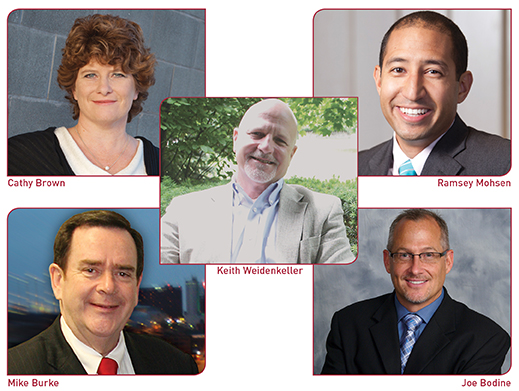HOME | ABOUT US | MEDIA KIT | CONTACT US | INQUIRE
HOME | ABOUT US | MEDIA KIT | CONTACT US | INQUIRE

Running a successful business in many cases comes down to applying the correct dosages of common sense at precisely the right time. There are occasions, though, when workplace situations call for a little uncommon sense. How did author Mark Twain put it? It’s not what you don’t know, it’s what you do know that ain’t so.
Which is why it’s a good idea to consult those who can see big-picture issues from a granular perspective. The ones who have spent years, even decades, developing their expertise at levels that the business generalists will never experience.
In this segment of Ingram’s How-To series, we bring you words of guidance from the halls of benefits planning, work-force management, social media acumen, successful collaborations—and when the race has been won and it’s time to reap the rewards of a life’s work, finding the right business buyer.
No two business scenarios are ever exactly the same, but we turned to experts in those areas to help guide you through the thought processes that you can apply at your own organization. We hope you’ll find their input as informative as we have.

by Cathy Brown
Cathy Brown is senior vice president of human resources and tax for Overland Park based Ferrellgas.
When considering employment compensation, the numbers on a paycheck may come to mind first for both the employee and the business owner signing that check. But these days, payroll is a shrinking part of an effective compensation package.
At the core of every salary and benefits plan, regardless of company size, lies one issue: What is the cost to the company to fund the total package? That’s difficult to answer, because decisions about benefit-plan structures can be more complex and confusing than determining a base wage or salary. A business owner must consider a variety of factors:
• The frequency of a benefit: Is it current or deferred?
• How will that benefit be administered, from responsibility for the program itself to communication of it to employees?
• What purpose is to be served by a particular feature of a benefit program? Is it health-related? Is it retirement? Is it a retention tool?
Myriad variables mean employers must evaluate the demographics of their employee population. Younger workers generally have less interest in certain benefits and more interest in cash or paid time off. Employees with dependents will likely place more value on health benefits, and an aging population will place more value on retirement benefits.
Regulatory, economic and policy changes are putting pressure on compensation plans, and in the current environment, the areas most affected are health-insurance and retirement benefits.
First, the health-care piece. For those companies with more than 50 employees, providing health-care coverage is no longer an option, unless they choose to pay the penalties for opting out. Employers offering coverage must comply with numerous government requirements; they must review any contracts they might have with collective bargaining units, and they need to evaluate all legal and contractual obligations that might exist.
Making sure that you’re following ever-changing requirements is, in itself, one set of pressures. There are financial pressures, too, in complying with Affordable Care Act regulations, as multiple reporting requirements add costs and time for employers. So an employer must evaluate not only the company’s cost share of plans, but must consider the costs borne by employees, and then must look at what plans are being offered on a voluntary basis before eventually making a decision about whether or not to continue them. What are the administrative costs of the non-health plans? What are the participation levels, as with disability or life insurance policies?
On the retirement side, for companies large and small, there are regulatory as well as fiscal-policy pressures involved: Given the current and projected fundamentals of Social Security, the federal government is encouraging companies to steer employees toward their own retirement planning and saving.
This is where an effective program communication plan comes in. Companies must educate employees on the benefit of retirement savings and encourage participation and engagement. History and experience indicates that people generally won’t do something for themselves, but if forced to do it, they usually find value later and are appreciative that it occurred.
But there are costs associated with enhancing retirement plans. For example, employers will need to carefully consider turnover rates before adopting a safe-harbor retirement plan where employees might have immediate vesting of the company match. And higher participation in any plan, while generally the overall goal, implies higher company costs to consider.
Health care and retirement aspects are key pillars of a benefits program, and their costs, as they continue to rise, squeeze other elements of your overall plan. But employers do have the ability to control outcomes; if they decide that it’s more cost effective to end health care coverage and pay the comparatively smaller penalty, the difference can still be used to strengthen other benefits available. Done right, that approach can minimize the human-capital risk associated with ending health coverage.
Remember: The ultimate goal of any benefits program is to increase the attractiveness of a company to an individual so that they will be interested not just in coming to work for the organization, but staying on for many years. The decisions you make in framing a complete compensation package will go a long way toward bringing on—and retaining—top talent.

by Ramsey Mohsen
Ramsey Mohsen is the chief executive officer of Everhance a Kansas City based social news and edutainment company.
I often have conversations with marketing pros and members of the C-suite who say the world of technology is moving so fast, that they are struggling to keep up. Many are attracted by the newest shiny object (e.g. Apps like Snapchat, Periscope). They are constantly reading headlines and stories of businesses seeing great success with social media. But when it comes to running their own business, these same people struggle in answering the question, “How should we measure success with our social media efforts? What is the ROI?” And they hesitate in enabling their teams with the things they need to be successful. It’s one of the most frequent questions I hear.
Marketers often look in the wrong places for the right answers to give back to the C-Suite. They obsess over with the tools and the technology. Getting Likes, Followers, Views—the ROI in social media is not about the tools. It’s about how you’re using the tools to achieve real business objectives. Business outcomes that matter to the organization. Your goal isn’t to be good at Facebook; it’s to be better at business because of social media.
Here are some things to consider in order to ensure social media is aligned and successful for your business:
1) Educate the business. Do this frequently, not just once. I advise clients to conduct quarterly meetings (at minimum) that are cross-functional “Social Media Education Sessions.” This establishes a baseline of knowledge about the tools. The key is to make it a safe place for all to ask questions about how the tools work. Furthermore, these sessions should highlight specific social media efforts that have helped other businesses augment their sales, products, service, marketing and communications. Do not focus on your own business in these meetings. It’s easy to get derailed and focus on yourself, so set aside different meetings/sessions to discuss these topics.
2) Commit for the long-term. Far too often do I see episodic or sporadic approaches with social media. Businesses try and shortcut their efforts, making them seasonal, and expect immediate results. This couldn’t be more wrong. Social media is not a fad. And it’s more than just running a campaign. It’s an everyday expectation in the world we live in now. Much like you have processes that you’re constantly refining around customers who walk through the doors of your business, or workflows for customer-service calls received—the same is true for social media. It should be a part of how the business flows.
3) Define your persona(s) and their customer journey(s). The golden rule applies here; know the audience(s) you are trying to affect. Don’t stop short by only defining demographic information. Bucket groups based on their shared psychographics, emotional and practical needs. With each audience, map out all the steps in their customer journey from awareness to conversion. Take it a step further and define the loyalty stages post-purchase. Knowing this information will help you understand the strategies and tactics that are more effective for making them a customer and retaining them.
4) Set social media goals that ladder up through marketing objectives and business outcomes. To be successful, your social team needs to have a clear understanding of how the business operates. If they have a clear understanding of these objectives and outcomes desired, it sets the stage for them to put social strategies and tactics in place that support these efforts and achieve these goals (and more importantly, you can set measurements if this was achieved). When your social team presents results, they should take time to correlate how specific tactics are aligned to business outcomes or objectives that have been set and how to refine them.
5) Create quarterly and yearly budgets for your paid, earned and owned efforts on social. It’s a common misconception that because social media is free to use, large budgets are not needed. This couldn’t be more wrong. As with other traditional channels, when well-integrated in to your overall marketing efforts online and offline, supplementing your social tactics with paid spends can make a big impact.

by Mike Burke
Mike Burke is a founding partner of Burke and Payne, and led the development team for the new Hyatt Downtown convention hotel.
No matter what line of business you’re in, if you can’t collaborate, you’re not going to be in business very long. From clients and customers to vendors and regulators, the relationships you build will go a long way to determining your chances of success.
Most of those entail simple interactions between two individuals, where qualities like mutual respect, professionalism, exceeding expectations and doing what you say you do will lay the proper foundation for your business. Sometimes, though, large-scale collaborations are needed, with multiple players at the table, representing multiple organizations, and often with competing agendas.
It’s hard to think of a better real-world example of that challenge than in the area of public-private partnerships, which increasingly are part of the commercial development dynamic not just in Kansas City, but nationwide. With public-sector budgets squeezed at all levels, governmental units are less inclined to tackle large-scale projects on their own. That’s the case, too, with private investors and developers—given some of the unknowns out there (where interest rates are going, for example, or fluctuations in labor costs), many are unlikely to tackle big projects that may have a harder time generating a return on investment than smaller, proven development models.
The key to successful collaborations here, then, lies in a mutual understanding that neither the private sector nor public sector can do a given project by themselves. And it takes a fair amount of work to get both sides to understand their respective roles in a public-private partnership.
So what are the keys to driving a successful P3, or any multi-organization collaboration? Here are a few fundamentals that helped produce an agreement for the 800-room Downtown convention hotel plan introduced this month:
• Participants. It’s vital that people come to the table with one voice that represents their organization’s interests. In any dealing with a public body, you have a political side and a professional staff side from City Hall, County Courthouse or State Capitol. They aren’t always going to be aligned with one another—in fact, they rarely are—so getting them to agree on what the public-sector commitment can be, and what it can’t be, is crucial, especially when it comes to understanding the economic fundamentals of a project.
• Communication. Any large-scale P3 project is likely to include an architect, an engineer, a contractor, a construction consultant, financial analyst and lawyer—at a minimum. And that’s on just one side of the table. In the hotel deal, negotiations took place for 2½ years, so it was vital that lines of communication be open and clear. You can’t let “deal fatigue” affect your ability to keep people informed.
• Personalities. They’re not always going to fit neatly together, so understand that going in. The key to success is making sure you are playing to people’s strengths. Then you rely on them to do their jobs.
• Timetables. A great pitfall in any P3 effort is failure to establish clear deadlines, not just for the deliverable, but for each element of the structured proposal. Those of us who work in the greater Kansas City area are blessed to have a great deal of sophistication on the public side in terms of understanding the numbers involved. But the much bigger challenge is understanding timing. For a developer or investor, time is money; a city won’t always look at things in that way.
Developers put capital at risk, but a public entity, generally speaking, does not—it has procedures to protect its stake. You need to reach an understanding on the private side of what city procedures are, and on the public side of what the cost of delay is. With the hotel, that involved unknown variables such as interest rates and construction costs. Delays in the project could increase costs on both sides.
Those are a few broad brush strokes, and in any deal—well, you know where the devil lies. But a successful frame-work for collaboration can help get you to those details faster, with buy-in from all relevant parties.

by Keith Wiedenkeller
Keith Wiedenkeller is the founder of Ad Astra Business Solutions and former HR director for AMC Entertainment.
I hear a lot of talk these days from employers struggling with inter-generational differences in the work force. Older supervisors and leaders don’t connect with the values of their younger workers; younger workers are frustrated by outdated employment practices that conflict with their ideals.
As a human-resources professional, I used to discount most of this rhetoric. After all, we’re all individuals, there are exceptions to every rule, and there are several studies that show that the basic personality of the American worker has remained constant for decades. There are also studies showing that socio-economic status can trump other demographic differences in terms of values. So a wealthy Millennial raised in the suburbs may share few values with a working-class Millennial raised in an urban setting.
And doesn’t every generation think the generation following them is just a bit crazy?
That said, I have become more and more convinced, in light of recent research, that Millennials in particular (generally those born between the early ’80s and the early 2000s) are simply too different from their predecessors to ignore.
The most recent—and thus useful—information about Millennials comes from the Pew Research Center, in a 2014 study titled “Millennials in Adulthood.” The study shows an unprecedented “gap” in values between Millennials and their predecessor generations.
For instance, members of this generation are much more likely (74 percent chance) to be single than Gen-Xers or Boomers were at their age. They are very liberal in their views about most social issues, and are the most digitally connected generation in history. They are less trustful of others by a considerable margin, and while they are the best-educated generation in the work force, Millennials are the first generation in the modern era to be worse off financially than their predecessor generation.
Perhaps predictably, this skeptical generation is also less likely than any previous generation to consider themselves as “patriotic,” and is less likely to see differences in major political parties than its predecessors.
So what guidance does this—and other—data suggest for the workplace? Here are a few thoughts:
Live to Work? Millennials don’t ascribe to climbing the corporate ladder, so traditional incentives may mean less to them than workplace flexibility. They’re not clock-punchers, and may not respond well to rigid expectations about “face-time” in the office. However, because of their digital connectivity, Millennials consider themselves available 24/7 for work issues, blurring the line between home and work.
Generation “Why.” Millennials work best if you explain why something is important or needs to be done a certain way, if at all. Respect and trust must be earned. Millennials will not simply drink the Kool-Aid because the boss says so. The purpose of their work has to be clearly communicated, valued, and celebrated.
Managing the messages. Millennials have grown up sharing virtually everything on-line, and may share information in the workplace and across traditional communication boundaries that will leave older co-workers aghast. An entry-level Millennial might send a note directly to the CEO, just as if sharing with “friends” on social media. Avenues of open communication are critical to this generation.
“Lowest” Common Denominator. Most of the adjustments made for Millennial workers are well-received by older workers (even if not initially requested). Baby Boomers might be less likely to request working from home, but once they do it, may prefer it. While Boomers and Gen-Xers don’t need to know the “why” of what they’re being asked to do, in general, you’ll get better engagement and performance if they do.
Lastly, remember that diversity, when embraced, is a good thing … and this includes diversity in age. Having different perspectives at the table can make a company more innovative, creative, and agile than its competitors. The business case for diversity and inclusion (whether regarding age, disability, race, ethnicity, gender, or sexuality) driving business success is, by now, indisputable.

by Joe Bodine
Joe Bodine is an entrepreneur and founder of ABMI, which has been involved in more than 1,000 business sales.
During my 22 years selling companies, I have yet to meet an owner who’s comfortable throughout the selling process. Let’s face it: most entrepreneurs spend many years pouring blood, sweat and tears into building a company.
Often, a business owner will use life savings, including leveraging a home, and even borrowing money from family and investors, to make the dream a reality. With so much at stake, finding the right buyer is critical in order to transition into the next life phase without an endless string of headaches and mounting expenses.
Unfortunately, every business owner hears horror stories of abysmal seller financing requirements, and brokers who charge large up-front fees and lack the expertise to accurately market and represent the business you’ve worked so hard to create. With that in mind, where do you start looking for the right buyer and how do you know when you’ve found the right one?
Some business owners try to locate buyers without help from a professional, and many will attest it’s nearly impossible to avoid the many pitfalls accompanying brokering the sale of your own business. Even if it’s a close friend or family member purchasing the business, there are legal and financial consequences most business owners never consider; this usually ends up costing tens or hundreds of thousands of dollars and can create tension under the best of circumstances.
While looking for the right buyer, you have to stay focused on running your business, and remain upbeat and positive, even if you’re having major burnout—the perfect buyer will relate to the passion and ambition you have, along with bringing a different skill set, ideas and plenty of new working capital.
Selling your business is the same process, regardless of who is selling or buying. Documenting the company’s financial, operational, marketplace and cultural condition, in an accurate and concise manner, is paramount for buyer confidence.
Always include areas of opportunity, as well as the strengths of the business, in a professional marketing package. In addition to building trust and allowing a buyer to make an educated decision, showing areas needing provement may attract a buyer who’s talented and skilled in these areas, and provide an avenue for potential growth. The right buyer will intuitively know when it’s a good fit for them after reviewing the package. As confidentiality is important, non-disclosures and the right “teaser” must be crafted carefully.
The questions below will help you determine your next steps and also help you think through who may be the right buyer:
Where is your business in its life cycle? Is it an early-stage business and in a market well positioned for growth? Is it a business with steady revenues and profitability? Is my business aging and in need of significant investment?
Have I done a good job preparing my business to sell? Do you have solid financial and operational records? Have you created a system that allows your business to operate without you working 24/7?
What are the opportunities to take it to a new level? Are there expenses you’ve left unchecked or are there markets you would pursue if you had the energy of a new owner? Do you have “blind spots” a new owner could shed light on? Could your business be combined with a competitor/related business and create significant value?
What type of deal makes sense for me? Do I need all my money upfront? Am I willing to help finance some of the purchase over a period of time? How long am I willing to stay involved with the business? Have I thought through all the tax implications of a sale?
Hiring a professional to find that right buyer will protect you, however, due diligence is required, as many brokers work alone, and focus on personal gain rather than your interests.
Interview, check references, and follow your intuition—all traits that helped you become successful. A seasoned professional will provide an expert business valuation as well as sales, marketing and project management throughout the process. As well, they are there to provide advice and help ensure all parties have the right resources and partners available when needed to provide for a smoother transition.